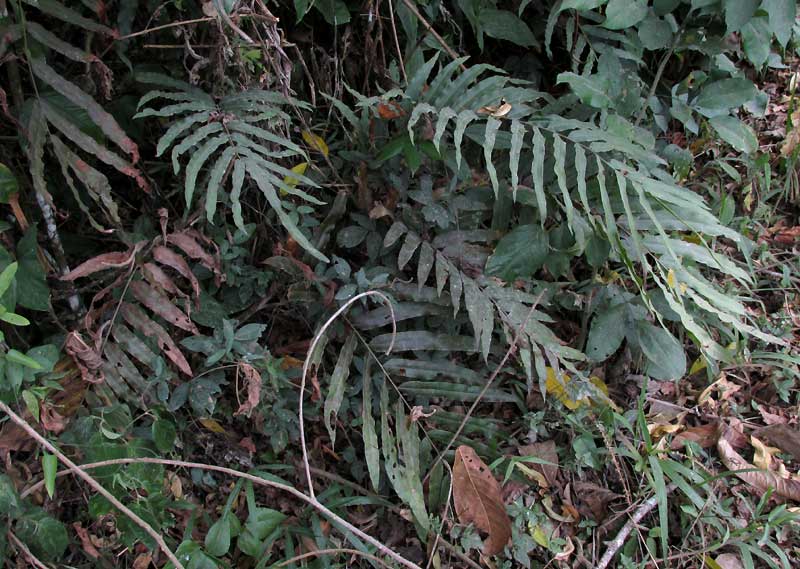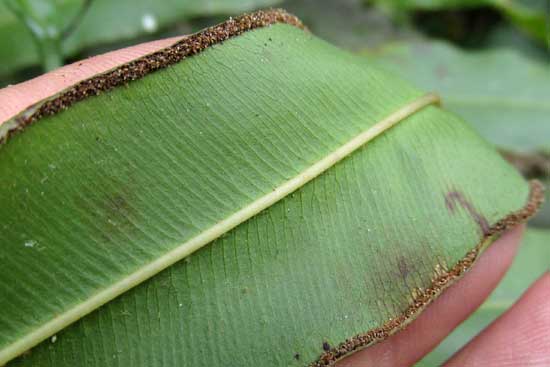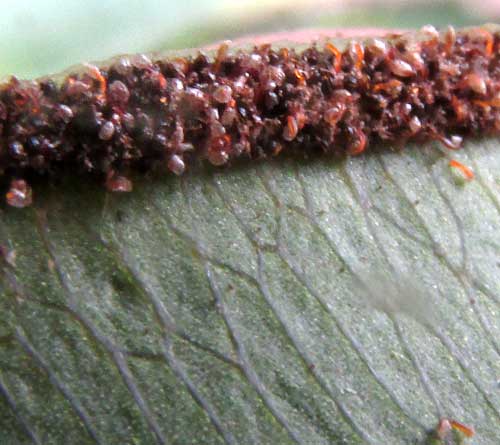Excerpts from Jim Conrad's
Naturalist Newsletter
from the May 8, 2016 Newsletter with notes from a visit in mid April to Lacanja Chansayab in the Lacandon Reserve; elevation 200m (650ft), N16.604°, W90.917°; Chiapas, MÉXICO
ELEPHANTLEAF BRAKE FERN
On April 14th when I was hiking small gravel backroads around Lacanja Chansayab in Chiapas's Lacandon Reserve, not far from where the climbing fern had turned up, and similarly entangled among a dense wall of tree and shrub branches, there were more typical-looking ferns, though big ones, with fronds about six feet long (2m). Below, you can see them reaching for the road's light:

Because of their large size, at first I thought these might be the Giant Leather Ferns often seen in the mangroves and marshes along the coast, but those ferns produce their spores in clusters (sori) scattered all across their fertile fronds' lower faces, while below you can see the very different situation on these Chiapas ferns:

In this species, the spore-producing sporangia are clustered beneath the frond segment's curved-under margins, which serve as the indusium. In fern parlance, such turned-under margins are said to be "revolute."
Up north the best-known ferns with sporangia gathered beneath revolute margins are the Bracken -- maybe the most abundant fern on Earth -- and the various cliffbrake species. Those ferns belong to the Brake Fern Family, the Pteridaceae, so when we look for members of the Pteridaceae found in lowland Chiapas it's easy enough to figure out that our big fern is PTERIS GRANDIFOLIA, often known as the Elephantleaf Brake.
Elephantleaf Brake has its English name by virtue of the species' occurrence in Florida and the Caribbean as well as central Mexico south through Central America, and in South America south to Peru. Other Pteris species occur in Chiapas but they're not as large, plus the fronds' venation underneath is distinctive. Below, a close look at both the veins and the sporangia:

Sporangia are like little bags full of spores. Across each sporangium's top there's a crest-like ridge of cells. When the sporangia are mature and the weather is dry, the crest-cells start drying up and shrinking. This causes tension to develop across the sporangium's thin surface. At a certain point the tension becomes so great that the sporagnium bag breaks open with a snap, and spores are thrown out, to be carried away on the wind. In the picture you can see empty sporangium covers and the slender, narrow, orangish, connected-together ridge cells that snapped them open.